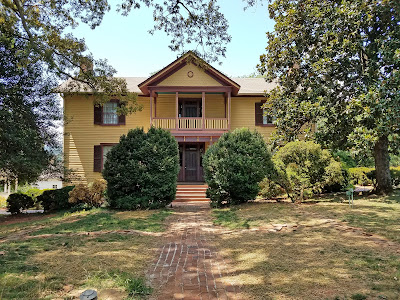 |
| Lunch was at Michie Tavern (c 1784) for a taste of 18C southern fare in a rustic setting |
 |
| Driveway to Highlands, the former property of President James Monroe |
 |
| Vegetable garden |
 |
| One big tomato! (KSS) |
 |
| Quercus alba/White Oak is at least 300 years old |
 |
| Reproduction overseer's house (left) and enslaved people's quarters (right) |
 |
| Corn crib |
 |
| Well in the herb garden, with the smokehouse back on the right |
 |
| Initially this building was thought to be the Monroe house, but later research showed it was their guest house (1818) |
 |
| Massey House (1870) was built by later owners |
 |
| In 2016, archaeological findings uncovered the foundation and fireplace of what was the Monroe house, in the front yard of the Massey House, with a kitchen wing extending under the Massey House |
 |
| Statue (c 1890s, by Attilio Piccirilli) of James Monroe was commissioned by Venezuela in tribute to the Monroe Doctrine, but after decades in the artist's studio, it was placed at Highland in 1932 |
 |
| Bust (1958, by Cathe Wallendahl) of James Monroe (KSS) |
Earlier Monroe was involved in the Louisiana Purchase, serving as assistant to Ambassador Robert Livingston in negotiations with the French government.
As to the question of slavery, James Monroe owned slaves but wrote that the practice was evil. He believed abolition should be gradual and advocated that the newly freed should be resettled in Africa or the Caribbean. However, his plantation grew tobacco, and later grain crops, that were not as lucrative as cotton, which did not grow in the Virginia Piedmont. Often in debt, Monroe ended up selling enslaved people to the south. A large group were sold to Casa Bianca, a cotton plantation in Florida, in 1828. Through records, the descendants of these families that were kept together could be found to give their stories of life in Highland.
Next: James Madison's Montpelier.

No comments:
Post a Comment